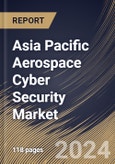The Asia Pacific Aerospace Cyber Security Market would witness market growth of 8.8% CAGR during the forecast period (2023-2030).
The China market dominated the Asia Pacific Aerospace Cyber Security Market by Country in 2022, and would continue to be a dominant market till 2030; thereby, achieving a market value of $3,636.7 Million by 2030. The Japan market is registering a CAGR of 8.1% during (2023 - 2030). Additionally, The India market would showcase a CAGR of 9.5% during (2023 - 2030).
Ground control systems and air traffic management infrastructure are prime targets for cyber attackers. The ramifications of a cyber-attack targeting these systems transcend individual aircraft and have the capacity to affect the aviation ecosystem as a whole. Ensuring the resilience of ground-based systems is paramount to maintaining air travel's overall safety and efficiency.
Furthermore, leveraging machine learning and artificial intelligence (AI) has become a prominent trend in aerospace cybersecurity. These technologies enable advanced threat detection, anomaly identification, and adaptive defense mechanisms. The ability of the industry to efficiently address advanced cyber threats is bolstered through continuous learning and adaptation to emerging attack vectors facilitated by machine learning and AI.
The growth in China's aerospace industry is driven by ambitious projects, such as space exploration, satellite launches, and the development of advanced aircraft. It is imperative that government agencies, aerospace companies, and cybersecurity experts work in tandem to devise and execute cybersecurity solutions that are both efficient and customized to the unique requirements of the aerospace sector. As per the data from the International Trade Administration, in the Chinese civil aerospace industry, from 2020 to 2021, the annual passenger throughput increased by 5.9%, from 860 million to 907 million. Thus, Asia Pacific’s growing aerospace sector will boost the region's demand.
Based on Component, the market is segmented into Services and Solutions. Based on Application, the market is segmented into Aircraft, Drones and Satellite. Based on Deployment, the market is segmented into On-Premise and Cloud. Based on Type, the market is segmented into Network Security, Content Security, Wireless Security, and Cloud Security. Based on countries, the market is segmented into China, Japan, India, South Korea, Singapore, Malaysia, and Rest of Asia Pacific.
The China market dominated the Asia Pacific Aerospace Cyber Security Market by Country in 2022, and would continue to be a dominant market till 2030; thereby, achieving a market value of $3,636.7 Million by 2030. The Japan market is registering a CAGR of 8.1% during (2023 - 2030). Additionally, The India market would showcase a CAGR of 9.5% during (2023 - 2030).
Ground control systems and air traffic management infrastructure are prime targets for cyber attackers. The ramifications of a cyber-attack targeting these systems transcend individual aircraft and have the capacity to affect the aviation ecosystem as a whole. Ensuring the resilience of ground-based systems is paramount to maintaining air travel's overall safety and efficiency.
Furthermore, leveraging machine learning and artificial intelligence (AI) has become a prominent trend in aerospace cybersecurity. These technologies enable advanced threat detection, anomaly identification, and adaptive defense mechanisms. The ability of the industry to efficiently address advanced cyber threats is bolstered through continuous learning and adaptation to emerging attack vectors facilitated by machine learning and AI.
The growth in China's aerospace industry is driven by ambitious projects, such as space exploration, satellite launches, and the development of advanced aircraft. It is imperative that government agencies, aerospace companies, and cybersecurity experts work in tandem to devise and execute cybersecurity solutions that are both efficient and customized to the unique requirements of the aerospace sector. As per the data from the International Trade Administration, in the Chinese civil aerospace industry, from 2020 to 2021, the annual passenger throughput increased by 5.9%, from 860 million to 907 million. Thus, Asia Pacific’s growing aerospace sector will boost the region's demand.
Based on Component, the market is segmented into Services and Solutions. Based on Application, the market is segmented into Aircraft, Drones and Satellite. Based on Deployment, the market is segmented into On-Premise and Cloud. Based on Type, the market is segmented into Network Security, Content Security, Wireless Security, and Cloud Security. Based on countries, the market is segmented into China, Japan, India, South Korea, Singapore, Malaysia, and Rest of Asia Pacific.
List of Key Companies Profiled
- Honeywell International, Inc.
- Lockheed Martin Corporation
- Astronautics Corporation of America
- Thales Group S.A.
- BAE Systems PLC
- Airbus SE
- Northrop Grumman Corporation
- The Aerospace Corporation
- Cisco Systems Inc.
Market Report Segmentation
By Component- Services
- Solutions
- Aircraft
- Drones
- Satellite
- On-Premise
- Cloud
- Network Security
- Content Security
- Wireless Security
- Cloud Security
- China
- Japan
- India
- South Korea
- Singapore
- Malaysia
- Rest of Asia Pacific
Table of Contents
Chapter 1. Market Scope & Methodology
Chapter 2. Market at a Glance
Chapter 3. Market Overview
Chapter 4. Asia Pacific Aerospace Cyber Security Market by Component
Chapter 5. Asia Pacific Aerospace Cyber Security Market by Application
Chapter 6. Asia Pacific Aerospace Cyber Security Market by Deployment
Chapter 7. Asia Pacific Aerospace Cyber Security Market by Type
Chapter 8. Asia Pacific Aerospace Cyber Security Market by Country
Chapter 9. Company Profiles
Companies Mentioned
- Honeywell International, Inc.
- Lockheed Martin Corporation
- Astronautics Corporation of America
- Thales Group S.A.
- BAE Systems PLC
- Airbus SE
- Northrop Grumman Corporation
- The Aerospace Corporation
- Cisco Systems Inc.
Methodology

LOADING...









